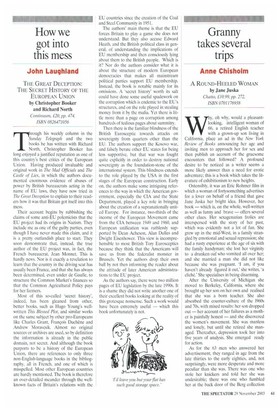How we got into this mess
John Laughland
THE GREAT DECEPTION: THE SECRET HISTORY OF THE EUROPEAN UNION by Christopher Booker and Richard North Continuum, £20, pp. 474. ISBN 0826471056 TNTrough his weekly column in the Sunday Telegraph and the two he has written with Richard North, Christopher Booker has long enjoyed a justified reputation as one of this country's best critics of the European Union. Having produced invaluable and original work in The Mad Officials and The Castle of Lies, in which the authors documented enormous evidence of abuses of power by British bureaucrats acting in the name of EU laws, they have now tried in The Great Deception to explain to their readers how it was that Britain got itself into this mess.
Their account begins by rubbishing the claims of some anti-EU polemicists that the EU project had its origins in Nazism. They include me as one of the guilty parties, even though I have never made this claim, and it is a pretty outlandish place to start. They soon demonstrate that, instead, the true author of the EU project was, in fact, the French bureaucrat, Jean Monnet. This is hardly news. Nor is it exactly a revelation to learn that the country in the driving seat has usually been France, and that she has always been determined, even under de Gaulle, to structure the Common Market's finances so that the Common Agricultural Policy pays for her farmers.
Most of this so-called 'secret history', indeed, has been gleaned from other, better books, such as Hugo Young's wellwritten This Blessed Plot, and similar works on the same subject by other pro-Europeans like Charles Grant, Francois Duchene and Andrew Moravcsik, Almost no original sources or archives are used, so by definition the information is already in the public domain, not secret. And although the book purports to be a history of the European Union, there are references to only three non-English-language books in the bibliography, all in French, and one of which is misspelled. Most other European countries are hardly mentioned. The book is therefore an over-detailed meander through the wellknown facts of Britain's relations with the EU countries since the creation of the Coal and Steel Community in 1951.
The authors' main theme is that the EU forces Britain to play a game she does not understand. But they also accuse Edward Heath, and the British political class in general, of understanding the implications of EU membership and then consciously lying about them to the British people. Which is it? Nor do the authors consider what it is about the structure of modem European democracies that makes all mainstream political parties support EU membership. Instead, the book is notable mainly for its omissions. A 'secret history' worth its salt could have done some useful spadework on the corruption which is endemic to the EU's structures, and on the role played in stealing money from it by the mafia. Yet there is little more than a page on corruption among hundreds of tedious pages about summitry.
Then there is the familiar blindness of the British Eurosceptic towards attacks on sovereignty from quarters other than the EU. The authors support the Kosovo war, and falsely berate other EU states for being less supportive, but that war was fought quite explicitly in order to destroy national sovereignty as the foundation-stone of the international system. This blindness extends to the role played by the USA in the first stages of the European construction. Early on, the authors make some intriguing references to the way in which the American government, especially the CIA and the State Department, played a key role in bringing about the creation of a supranationally united Europe. For instance, two-thirds of the income of the European Movement came from the CIA between 1949 and 1960, and European unification was ruthlessly supported by Dean Acheson, Alan Dulles and Dwight Eisenhower. This view is incomprehensible to most British Tory Eurosceptics because they think that the Americans will save us from the federalist monster in Brussels. Yet the authors drop their own ball by not then informing the reader about the attitude of later American administrations to the EU project.
As the authors say, there were two million pages of EU legislation by the late 1990s. It is a shame they did not write another one of their excellent books looking at the reality of this grotesque nonsense. Such a work would have been extremely useful — which this book unfortunately is not.


























































































 Previous page
Previous page